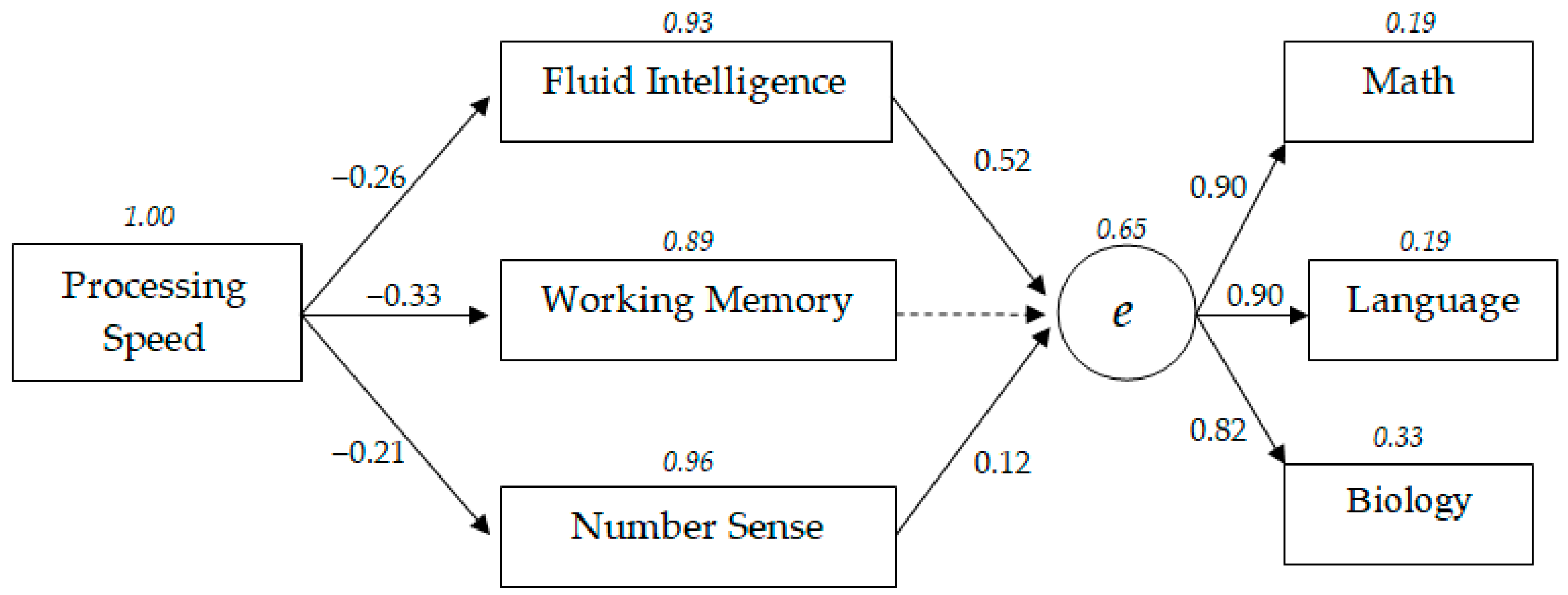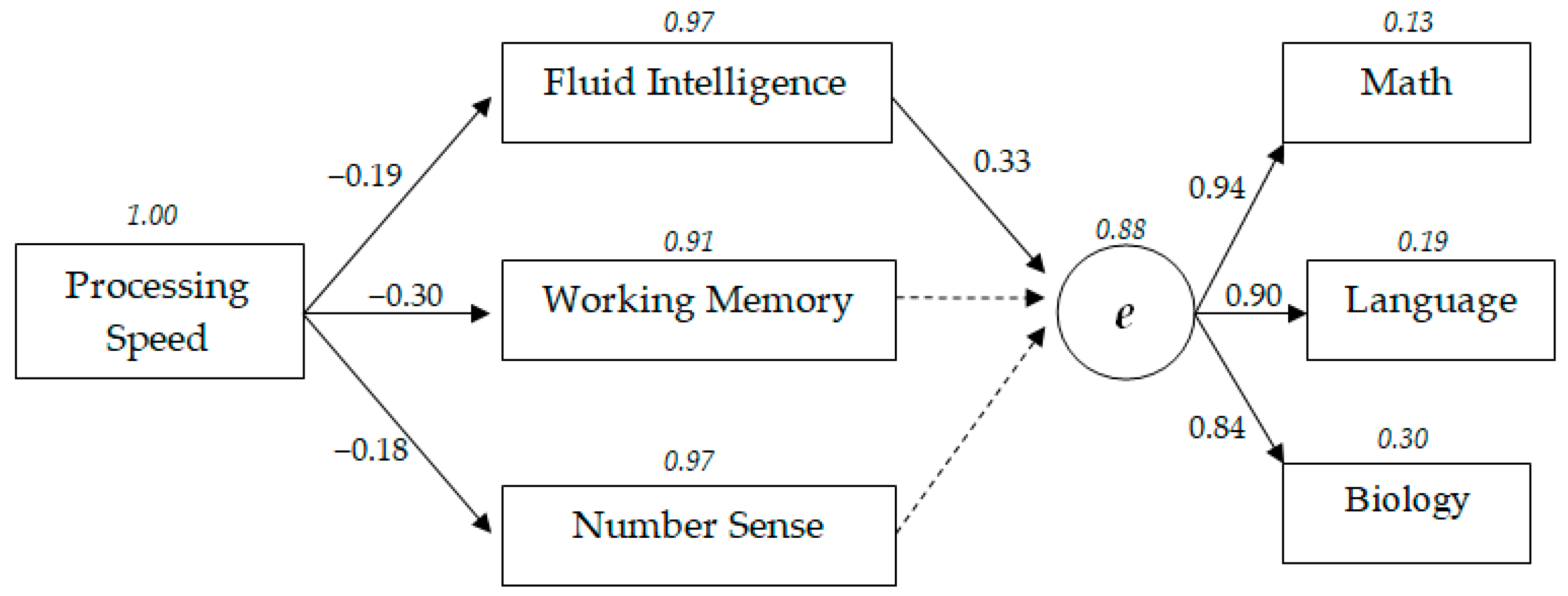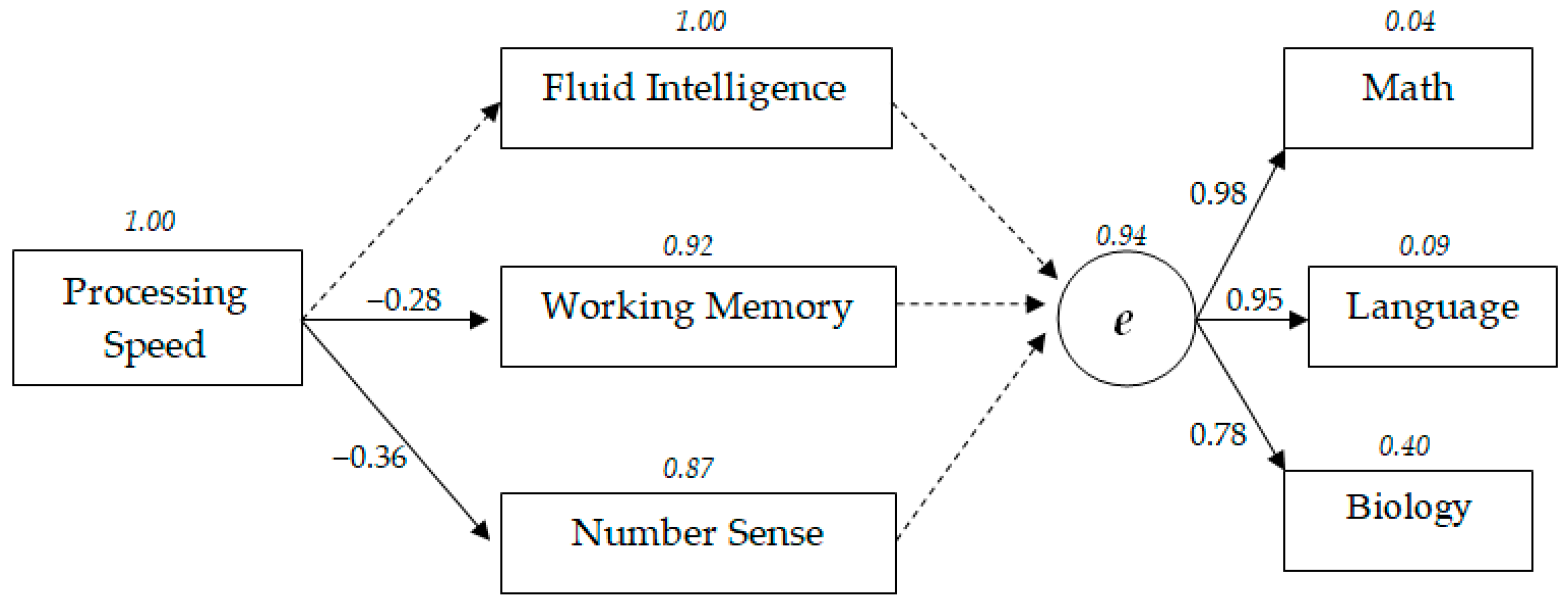Predicting Academic Achievement with Cognitive Abilities: Cross-Sectional Study across School Education
Abstract
:1. Introduction
2. Materials and Methods
2.1. Participants
2.2. Measures
2.2.1. Cognitive Abilities
Choice Reaction Time Test, Information Processing Speed
Corsi Tapping-Block Test, Visuospatial Working Memory
Dot Task Test, Number Sense
Standard Progressive Matrices Test, Fluid Intelligence
2.2.2. Academic Achievement
2.3. Statistical Approach
- Model 1: Cognitive characteristics affect academic success through the latent variable of general cognitive ability “g”;
- Model 2: Cognitive characteristics—information processing speed, visuospatial working memory, number sense, and fluid intelligence—contribute to general academic achievement “e” (“education”);
- Model 3: Information processing speed is a key predictor of fluid intelligence, working memory, and number sense, which in turn contribute to general academic achievement.
3. Results
3.1. Correlation Analysis
3.2. Structural Modeling
4. Discussion
5. Conclusions
Author Contributions
Funding
Acknowledgments
Conflicts of Interest
References
- Verbitskaya, L.A.; Zinchenko, Y.P.; Malykh, S.B.; Gaidamashko, I.V.; Kalmyk, O.A.; Tikhomirova, T.N. Cognitive Predictors of Success in Learning Russian Among Native Speakers of High School Age in Different Educational Systems. Psychol. Russ. State Art 2020, 13, 2–15. [Google Scholar] [CrossRef]
- Rohde, T.E.; Thompson, L.A. Predicting academic achievement with cognitive ability. Intell. 2007, 35, 83–92. [Google Scholar] [CrossRef]
- Deary, I.J.; Strand, S.; Smith, P.; Fernandes, C. Intelligence and educational achievement. Intell. 2007, 35, 13–21. [Google Scholar] [CrossRef]
- Halberda, J.; Mazzocco, M.M.; Feigenson, L. Individual differences in nonverbal estimation ability predict maths achievement. Nature. 2008, 455, 665–668. [Google Scholar] [CrossRef] [PubMed]
- Luo, D.; Thompson, L.A.; Detterman, D.K. The criterion validity of tasks of basic cognitive processes. Intell. 2006, 34, 79–120. [Google Scholar] [CrossRef]
- Tikhomirova, T.; Kuzmina, Y.; Lysenkova, I.; Malykh, S. Development of approximate number sense across the elementary school years: A cross-cultural longitudinal study. Dev. Sci. 2019, 22, e12823. [Google Scholar] [CrossRef]
- Rodic, M.; Zhou, X.; Tikhomirova, T.; Wei, W.; Malykh, S.; Ismatullina, V.; Sabirova, E.; Davidova, Y.; Tosto, M.; Lemelin, J.-P.; et al. Cross-cultural investigation into cognitive underpinnings of individual differences in early arithmetic. Dev. Sci. 2014, 18, 165–174. [Google Scholar] [CrossRef] [Green Version]
- Laidra, K.; Pullmann, H.; Allik, J. Personality and intelligence as predictors of academic achievement: A cross-sectional study from elementary to secondary school. Pers. Individ. Differ. 2007, 42, 441–451. [Google Scholar] [CrossRef]
- Verbitskaya, L.A.; Malykh, S.; Tikhomirova, T. Cognitive Predictors of Success in Learning Russian in Native and Non-native Speakers at High School Age. Procedia—Soc. Behav. Sci. 2017, 237, 1236–1241. [Google Scholar] [CrossRef]
- Geary, D.C. Cognitive predictors of achievement growth in mathematics: A 5-year longitudinal study. Dev. Psychol. 2011, 47, 1539–1552. [Google Scholar] [CrossRef] [Green Version]
- Rose, S.A.; Feldman, J.F.; Jankowski, J.J. Modeling a cascade of effects: The role of speed and executive functioning in preterm/full-term differences in academic achievement. Dev. Sci. 2011, 14, 1161–1175. [Google Scholar] [CrossRef]
- Brown, L.A.; Brockmole, J.R.; Gow, A.J.; Deary, I.J. Processing Speed and Visuospatial Executive Function Predict Visual Working Memory Ability in Older Adults. Exp. Aging Res. 2012, 38, 1–19. [Google Scholar] [CrossRef] [PubMed]
- Rindermann, H.; Neubauer, A. Processing speed, intelligence, creativity, and school performance: Testing of causal hypotheses using structural equation models. Intell. 2004, 32, 573–589. [Google Scholar] [CrossRef]
- Semmes, R.; Davison, M.L.; Close, C. Modeling Individual Differences in Numerical Reasoning Speed as a Random Effect of Response Time Limits. Appl. Psychol. Meas. 2011, 35, 433–446. [Google Scholar] [CrossRef]
- Tikhomirova, T.N.; Malykh, S.B.; Tosto, M.G.; Kovas, Y.V. Cognitive characteristics and mathematical achievement in high school students: Cross-cultural analyses. Psihologicheskij Zhurnal 2014, 35, 41–53. [Google Scholar]
- Der, G.; Deary, I.J. Age and sex differences in reaction time in adulthood: Results from the United Kingdom Health and Lifestyle Survey. Psychol. Aging 2006, 21, 62–73. [Google Scholar] [CrossRef] [Green Version]
- Fry, A.F.; Hale, S. Relationships among processing speed, working memory, and fluid intelligence in children. Biol. Psychol. 2000, 54, 1–34. [Google Scholar] [CrossRef]
- Tikhomirova, T. Spatial Thinking and Memory in Russian High School Students with Different Levels of Mathematical Fluency. Procedia—Soc. Behav. Sci. 2017, 237, 1260–1264. [Google Scholar] [CrossRef]
- Bull, R.; Espy, K.A.; Wiebe, S.A. Short-Term Memory, Working Memory, and Executive Functioning in Preschoolers: Longitudinal Predictors of Mathematical Achievement at Age 7 Years. Dev. Neuropsychol. 2008, 33, 205–228. [Google Scholar] [CrossRef] [Green Version]
- Verbitskaya, L.A.; Malykh, S.B.; Zinchenko, Y.P.; Tikhomirova, T.N. Cognitive predictors of success in learning Russian. Psychol. Russ. State Art. 2015, 8, 91–100. [Google Scholar] [CrossRef] [Green Version]
- Van der Sluis, S.; van der Leij, A.; de Jong, P.F. Working memory in Dutch children with reading- and arithmetic-related LD. J. Learn. Disabil. 2005, 38, 207–221. [Google Scholar] [CrossRef]
- Tikhomirova, T.N.; Modyaev, A.D.; Leonova, N.M.; Malykh, S.B. Factors of academic achievement at primary school level: Sex differences. Psihologicheskij zhurnal. 2015, 36, 43–54. [Google Scholar]
- Inglis, M.; Attridge, N.; Batchelor, S.; Gilmore, C. Non-verbal number acuity correlates with symbolic mathematics achievement: But only in children. Psychon. Bull. Rev. 2011, 18, 1222–1229. [Google Scholar] [CrossRef] [PubMed] [Green Version]
- Soltész, F.; Szűcs, D.; Szűcs, L. Relationships between magnitude representation, counting and memory in 4- to 7-year-old children: A developmental study. Behav. Brain Funct. 2010, 6, 13. [Google Scholar] [CrossRef] [Green Version]
- Nisbett, R.E.; Aronson, J.; Blair, C.; Dickens, W.; Flynn, J.; Halpern, D.F.; Turkheimer, E. Intelligence: New findings and theoretical developments. Am. Psychol. 2012, 67, 130–159. [Google Scholar] [CrossRef]
- Brouwers, S.A.; Van de Vijver, F.J.R.; Van Hemert, D.A. Variation in Raven’s Progressive Matrices scores across time and place. Learn. Individ. Differ. 2009, 19, 330–338. [Google Scholar] [CrossRef] [Green Version]
- Kuzmina, Y.; Tikhomirova, T.; Lysenkova, I.; Malykh, S. Domain-general cognitive functions fully explained growth in nonsymbolic magnitude representation but not in symbolic representation in elementary school children. PLoS ONE 2020, 15, e0228960. [Google Scholar] [CrossRef]
- Tikhomirova, T.; Kuzmina, Y.; Lysenkova, I.; Malykh, S. The Relationship Between Non-symbolic and Symbolic Numerosity Representations in Elementary School: The Role of Intelligence. Front. Psychol. 2019, 10, 2724. [Google Scholar] [CrossRef] [Green Version]
- Tikhomirova, T.N.; Kuzmina, Y.V.; Malykh, S.B. Trajectories of processing speed development across primary school years: Longitudinal study. Psihologicheskij zhurnal. 2020, 41, 26–38. [Google Scholar]
- Suades-González, E.; Forns, J.; García-Esteban, R.; López-Vicente, M.; Esnaola, M.; Álvarez-Pedrerol, M.; Julvez, J.; Cáceres, A.; Basagaña, X.; López-Sala, A.; et al. A Longitudinal Study on Attention Development in Primary School Children with and without Teacher-Reported Symptoms of ADHD. Front. Psychol. 2017, 8, 655. [Google Scholar] [CrossRef]
- Isbell, E.; Fukuda, K.; Neville, H.J.; Vogel, E.K. Visual working memory continues to develop through adolescence. Front. Psychol. 2015, 6, 1–10. [Google Scholar] [CrossRef] [Green Version]
- Thaler, N.S.; Goldstein, G.; Pettegrew, J.W.; Luther, J.F.; Reynolds, C.R.; Allen, D.N. Developmental Aspects of Working and Associative Memory. Arch. Clin. Neuropsychol. 2013, 28, 348–355. [Google Scholar] [CrossRef] [Green Version]
- Alloway, T.P.; Alloway, R.G. Working memory across the lifespan: A cross-sectional approach. J. Cogn. Psychol. 2013, 25, 84–93. [Google Scholar] [CrossRef]
- Von Stumm, S.; Plomin, R. Socioeconomic status and the growth of intelligence from infancy through adolescence. Intell. 2015, 48, 30–36. [Google Scholar] [CrossRef] [Green Version]
- Tucker-Drob, E.M.; Briley, D.A. Continuity of genetic and environmental influences on cognition across the life span: A meta-analysis of longitudinal twin and adoption studies. Psychol. Bull. 2014, 140, 949–979. [Google Scholar] [CrossRef] [Green Version]
- Peng, P.; Kievit, R.A. The Development of Academic Achievement and Cognitive Abilities: A Bidirectional Perspective. Child Dev. Perspect. 2020, 14, 15–20. [Google Scholar] [CrossRef] [Green Version]
- Peng, P.; Wang, T.; Wang, C.; Lin, X. A meta-analysis on the relation between fluid intelligence and reading/mathematics: Effects of tasks, age, and social economics status. Psychol. Bull. 2019, 145, 189–236. [Google Scholar] [CrossRef]
- Follmer, D.J. Executive Function and Reading Comprehension: A Meta-Analytic Review. Educ. Psychol. 2017, 53, 42–60. [Google Scholar] [CrossRef]
- Caemmerer, J.M.; Maddocks, D.L.S.; Keith, T.Z.; Reynolds, M.R. Effects of cognitive abilities on child and youth academic achievement: Evidence from the WISC-V and WIAT-III. Intell. 2018, 68, 6–20. [Google Scholar] [CrossRef]
- Zheng, A.; Tucker-Drob, E.M.; Briley, D.A. National Gross Domestic Product, Science Interest, and Science Achievement: A Direct Replication and Extension of the Tucker-Drob, Cheung, and Briley (2014) Study. Psychol. Sci. 2019, 30, 776–788. [Google Scholar] [CrossRef] [Green Version]
- Tosto, M.G.; Tikhomirova, T.; Galajinsky, E.; Akimova, K.; Kovas, Y. Development and Validation of a Mathematics-number sense Web-based Test Battery. Procedia—Soc. Behav. Sci. 2013, 86, 423–428. [Google Scholar] [CrossRef] [Green Version]
- Hu, L.; Bentler, P.M. Cutoff criteria for fit indexes in covariance structure analysis: Conventional criteria versus new alternatives. Struct. Equ. Model. A Multidiscip. J. 1999, 6, 1–55. [Google Scholar] [CrossRef]



| Variable | Mean (Standard Deviation) |
|---|---|
| Fluid intelligence | 37.99 (9.48) 45.62 (6.76) 51.42 (5.06) |
| Information processing speed | 1.00 (0.32) 0.50 (0.20) 0.48 (0.20) |
| Visuospatial working memory | 2.50 (1.86) 4.30 (1.85) 4.99 (1.80) |
| Number sense | 95.48 (14.13) 104.20 (14.10) 109.60 (14.00) |
| Language | 3.95 (0.60) 3.90 (0.60) 3.91 (0.68) |
| Math | 4.06 (0.59) 3.80 (0.65) 3.94 (0.76) |
| Biology | 4.48 (0.53) 3.97 (0.63) 4.04 (0.69) |
| Variables | Language | Math | Biology |
|---|---|---|---|
| Processing speed | −0.02 −0.06 0.06 | −0.09 * −0.06 0.04 | −0.06 −0.04 0.01 |
| Working memory | 0.15 ** 0.11 ** 0.14 ** | 0.22 ** 0.11 * 0.10 | 0.17 ** 0.01 0.10 |
| Number sense | 0.24 ** 0.10 * 0.06 | 0.26 ** 0.13 ** 0.07 | 0,22 ** 0.04 0.10 |
| Fluid intelligence | 0.47 ** 0.33 ** 0.18 ** | 0.48 ** 0.36 ** 0.10 | 0.43 ** 0.27 ** 0.08 |
| Indices | AIC | BIC | CFI | TLI | RMSEA | RMSEAlow | RMSEAhigh |
|---|---|---|---|---|---|---|---|
| Primary | 6647.17 | −14125.86 | 0.996 | 0.991 | 0.027 | 0.000 | 0.055 |
| Secondary | 3304.24 | −11505.64 | 0.997 | 0.993 | 0.030 | 0.000 | 0.066 |
| High | 995.50 | −3274.59 | 1.006 | 1.013 | 0.000 | 0.000 | 0.000 |
Publisher’s Note: MDPI stays neutral with regard to jurisdictional claims in published maps and institutional affiliations. |
© 2020 by the authors. Licensee MDPI, Basel, Switzerland. This article is an open access article distributed under the terms and conditions of the Creative Commons Attribution (CC BY) license (http://creativecommons.org/licenses/by/4.0/).
Share and Cite
Tikhomirova, T.; Malykh, A.; Malykh, S. Predicting Academic Achievement with Cognitive Abilities: Cross-Sectional Study across School Education. Behav. Sci. 2020, 10, 158. https://doi.org/10.3390/bs10100158
Tikhomirova T, Malykh A, Malykh S. Predicting Academic Achievement with Cognitive Abilities: Cross-Sectional Study across School Education. Behavioral Sciences. 2020; 10(10):158. https://doi.org/10.3390/bs10100158
Chicago/Turabian StyleTikhomirova, Tatiana, Artem Malykh, and Sergey Malykh. 2020. "Predicting Academic Achievement with Cognitive Abilities: Cross-Sectional Study across School Education" Behavioral Sciences 10, no. 10: 158. https://doi.org/10.3390/bs10100158





